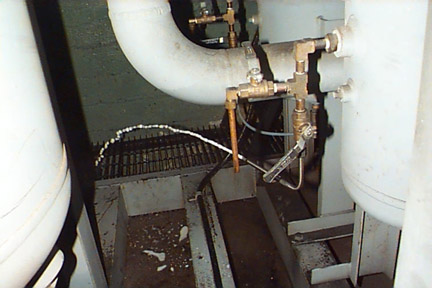 In a previous post, we discovered that air compressors will produce significant amounts of water, which is squeezed from the ambient air the compressor ingests through its intake. This water, if left in the system, can damage the air compressor and components connected to your compressed air system and possibly contaminate your product. Piping will rust, this rust will mix with the compressor oil and the dirt particles that are introduced into the system through the inlet of the compressor. This mixture forms a sticky mess that can clog pneumatic circuitry and stain or pit finely finished surfaces. In addition to this, because a compressed air system is an oxygen rich environment, microbes can start to grow within the piping, feeding off organic materials. If you have ever been sprayed with the wet discharge of a compressed air filter drain, this is the reason the condensate often smells like an old gym sock.
In a previous post, we discovered that air compressors will produce significant amounts of water, which is squeezed from the ambient air the compressor ingests through its intake. This water, if left in the system, can damage the air compressor and components connected to your compressed air system and possibly contaminate your product. Piping will rust, this rust will mix with the compressor oil and the dirt particles that are introduced into the system through the inlet of the compressor. This mixture forms a sticky mess that can clog pneumatic circuitry and stain or pit finely finished surfaces. In addition to this, because a compressed air system is an oxygen rich environment, microbes can start to grow within the piping, feeding off organic materials. If you have ever been sprayed with the wet discharge of a compressed air filter drain, this is the reason the condensate often smells like an old gym sock.
To attempt to minimize the amount of water that gets into system piping, most air compressors will have a water separator and trap of some kind. This trap is located right after the compressor aftercooler—a heat exchanger designed to cool the flow of compressed air that exits the compressor discharge. The trap will have some method of drainage to remove the water. The operation of this drain is the first thing to check if you are having moisture problems. A dry drain means trouble.
A failed drain will allow large amounts of water to enter the compressed air system. If there are no additional ways to trap this moisture and deal with it, then problems will occur. The first and best line of defense is to have a storage receiver in line just after the air compressors, to allow a place for the compressed air to cool and free water to settle; any captured water can be removed from an additional drain on the bottom of the receiver.
Compressed air piping practices are important to prevent water from ending up in production machinery. The piping should be sloped away from the compressor slightly. This way, any free water that condenses out of the stream of air as it cools will flow down to the lowest spot, where a drain should be located. Connection points feeding the production machines should be located on the top of the main distribution piping, so as not to allow water to drain down into critical locations.
Of course, having properly sized air dryers on your system will prevent any free water from forming in your piping. However, the piping design should be such that it minimizes any trouble that might be caused it the dryer fails for a significant period of time or is accidentally turned off.
Some other things to consider with regard to water in the compressed air system:
• Compressor connections should enter into the top of the compressor room piping header, the water produced by one compressor in a multiple compressor system can end up in the discharge piping of another compressor, filling it up completely. When the compressor needs to start, the water hammer can damage downstream filters, dryers, or the compressor itself.
• The water produced by air compressors is contaminated with dirt and compressor oil, it should be disposed of correctly so as not to pollute the environment.
• Free water, if allowed to enter desiccant style air dryers, will damage the desiccant.
• Water will rust piping and receiver tanks; drains must be working. The weight of a full receiver tank due to a drain failure can damage tank mounting in some extreme cases. Tanks must be inspected regularly to ensure the rust pitting has not created a safety hazard.
• Expanding ice can plug and crack pipes if wet air is directed outdoors in freezing conditions.
• Water, which is present in the lubricant, can damage the inside of lubricated screw air compressors if the compressors are not allowed to come up to operating temperature—this can happen in the case of oversized compressors.
• Water is a universal solvent, it will wash away beneficial lubricant in air compressors and in compressed air powered tools, causing early machine failure or excessive wear.

All of the statement s are true. Water, or even just moisture, is deadly to almost all pneumatic system components.